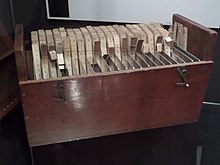| Cecil Arnold Beevers | |
|---|---|
 Beevers–Lipson strips, co-invented with Henry Lipson, on display at the Museum of the History of Science, Oxford, as part of the Crystals special exhibition in 2014. Beevers–Lipson strips, co-invented with Henry Lipson, on display at the Museum of the History of Science, Oxford, as part of the Crystals special exhibition in 2014. | |
| Born | (1908-05-27)27 May 1908 Manchester, England |
| Died | 16 January 2001(2001-01-16) (aged 92) Edinburgh, Scotland |
| Alma mater | University of Liverpool |
| Known for | X-ray diffraction Beevers–Lipson strips Beevers Miniature Models Beevers–Ross sites and anti-Beevers–Ross sites |
| Scientific career | |
| Fields | Crystallography |
| Institutions | University of Liverpool University of Manchester University of Hull University of Edinburgh |
| Doctoral students | William Cochran |
Cecil Arnold Beevers (27 May 1908 – 16 January 2001) was a British crystallographer, known for Beevers–Lipson strips, a computational aid for calculating Fourier transforms to determine the structure of crystals from crystallographic data, enabling the creation of models for complex molecules.
Life and career
C. Arnold Beevers was born in Manchester, England. His family moved to Liverpool and he attended the University of Liverpool, gaining a BSc degree in Physics in 1929, and a DSc degree in 1933.
At Liverpool University, Beevers was influenced by Professor Lionel Wilberforce. After he graduated, Beevers was invited to work on X-ray diffraction, together with Henry Lipson. The two scientists often visited the University of Manchester to seek advice from Lawrence Bragg. Subsequently, Beevers moved to a post at Manchester. Beevers explored the structure of the crystal Beta Alumina with Marion Ross at Manchester. They noted there were 'problem' sites in the areas occupied by mobile sodium ions. Subsequently, the presence of these ions was discovered to make this crystal an efficient fast-ion conductor. As a tribute to their discovery, the locations of these ions are now known as Beevers–Ross sites and anti-Beevers–Ross sites.
Beevers then had short appointment at the University of Hull, but in 1938 he became Dewar Fellow in Crystallography at the University of Edinburgh, a post that was jointly associated with the Departments of Physics and Chemistry. Beevers was elected a Fellow of the Royal Society of Edinburgh later in the same year. Beevers remained in Edinburgh for the rest of his life and was Reader in Crystallography at the University. His notable students included Douglas M. C. MacEwan FRSE.
Arnold Beevers was a Quaker and this influenced his approach to life and science. He was involved with disabled people and this was important in his development of Beevers Miniature Models (now operating as Miramodus Ltd.), ball-and-spoke molecular models used for education purposes, largely made by disabled workers, first produced in 1961.
Beevers–Lipson strips
Main article: Beevers–Lipson stripBeevers developed Beevers–Lipson strips with Henry Lipson CBE FRS (1910–1991), Professor of Physics at the University of Manchester Institute of Science and Technology (England). The approach converted the large calculations of multi-dimensional Fourier summations needed in crystallography analysis into sums of more manageable one-dimensional values. The folded card strips with numbers were stored in normally wooden boxes, one for sines and one for cosines. Previously it was necessary to consult sine/cosine tables, a time-consuming process.
Legacy
Beevers Miniature Models continued to be produced by Miramodus Ltd. at the University of Edinburgh. The British Crystallographic Association administers an Arnold Beevers Bursary Fund.
See also
References
- "Set of Beevers Lipson Strips, Sine Set, c.1936". Oxford: Museum of the History of Science. Retrieved 28 March 2014.
- ^ "Cecil Arnold Beevers" (PDF). Crystallography News. Royal Society of Edinburgh. 2001. Archived from the original (PDF) on 29 March 2014. Retrieved 28 March 2014.
- ^ Gould, Bob (December 1998). "The mechanism of Beevers–Lipson strips". BCA Newsletter. International Union of Crystallography. Retrieved 28 March 2014.
- Beevers, C. A.; Ross, M. A. S. (July 1937). "The crystal structure of "Beta Alumina" Na2O 11Al(2)O3". Zeitschrift für Kristallographie. 97 (1/2): 59–66. doi:10.1524/zkri.1937.97.1.59. S2CID 102121580.
- "Archived copy" (PDF). Archived from the original (PDF) on 8 October 2020. Retrieved 24 June 2017.
{{cite web}}: CS1 maint: archived copy as title (link) - ^ "(Cecil) Arnold Beevers". Gazetteer for Scotland. Retrieved 29 March 2014.
- "Beevers–Lipson strips in oak case". Collection of Historical Scientific Instruments. USA: Harvard University. Archived from the original on 29 March 2014. Retrieved 28 March 2014.
- "Arnold Beevers Bursary Fund deadline". British Crystallographic Association. Archived from the original on 14 March 2014. Retrieved 29 March 2014.
External links
Categories:- 1908 births
- 2001 deaths
- Scientists from Manchester
- Alumni of the University of Liverpool
- British chemists
- 20th-century British physicists
- British crystallographers
- Academics of the University of Liverpool
- Academics of the Victoria University of Manchester
- Academics of the University of Hull
- Academics of the University of Edinburgh
- British Quakers
- 20th-century Quakers
- Fellows of the Royal Society of Edinburgh